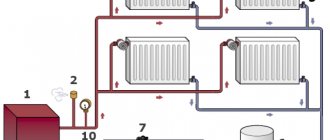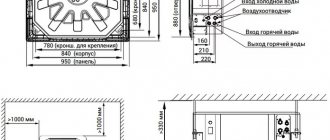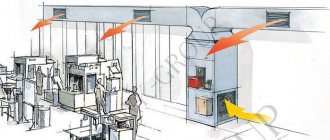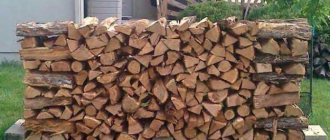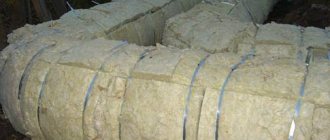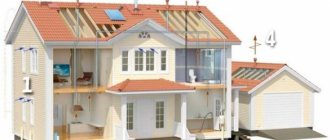Many of you have observed the appearance of droplets of moisture on surfaces - on cold water pipes, bath walls, windows, and also when things are moved from frost to room temperature. This can be explained simply: the object cools the surrounding air, provoking the formation of condensation.
The appearance of moisture occurs due to the difference in temperature inside and outside the room. This physical phenomenon is inextricably linked with the concept of "dew point". Let's figure out what the term means, consider its meaning in house insulation and give examples of self-calculation.
Physical term
The constantly growing and developing market for construction products presents a wide selection of materials for thermal insulation. It is necessary to approach the choice of thermal insulation for industrial and residential premises properly and pay attention to the indicator in question during construction.
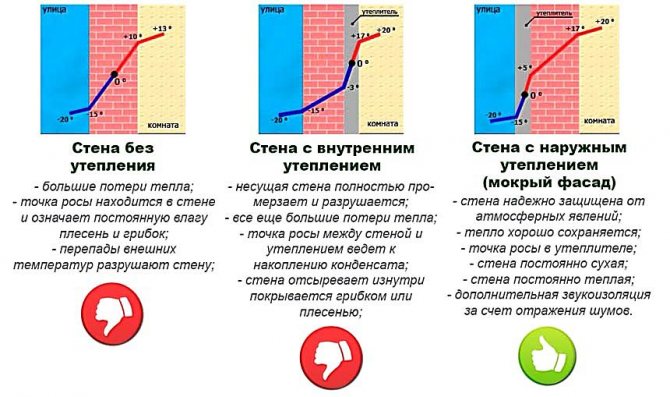
Due to the incorrect measurement of the dew point, the walls often fog up, the appearance of mold, and sometimes the destruction of structures.
The border of the transition from a low temperature outside the walls to a higher temperature inside the heated structures with possible condensation formation, experts consider the dew point. Water droplets will appear on any surface in the room that is close to or below the dew point temperature. The simplest example: in the middle of some rooms, in cold weather, condensation flows down on the window panes.
The main factors affecting the determination of the value are:
- climatic factors (temperature value and humidity outside);
- temperature values inside;
- humidity indicator inside;
- the value of the thickness of the walls;
- vapor permeability of thermal insulation used in construction;
- the presence of heating and ventilation systems;
- purpose of structures.
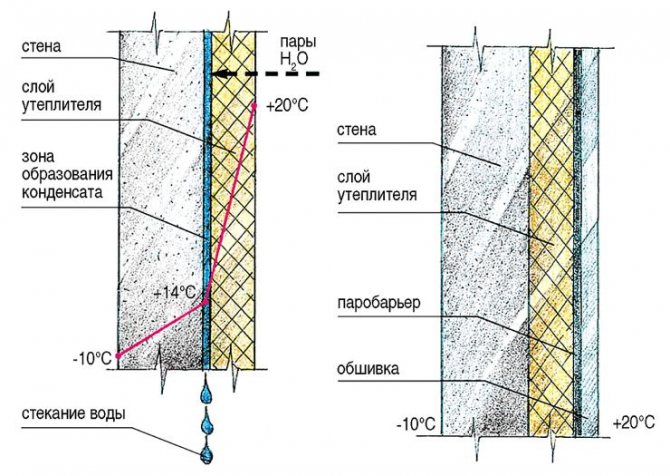

Correct dew point determination is essential in construction
All physical phenomena that are studied in the school physics course surround us without breaks for lunch, sleep and holidays. All life is physics, one way or another already mastered by humanity and still completely unexplored. For example, many natural phenomena recognized by physicists have found their scientific embodiment in the practical activity of man.
Here is the morning dew - the beauty of a summer morning. But from the same dew that falls in residential premises due to improperly installed windows, broken waterproofing and thermal insulation, you can get a huge number of problems. And certain parameters, when moisture falls on the surrounding surfaces, have received a beautiful name - dew point.
Consequences of incorrect calculations
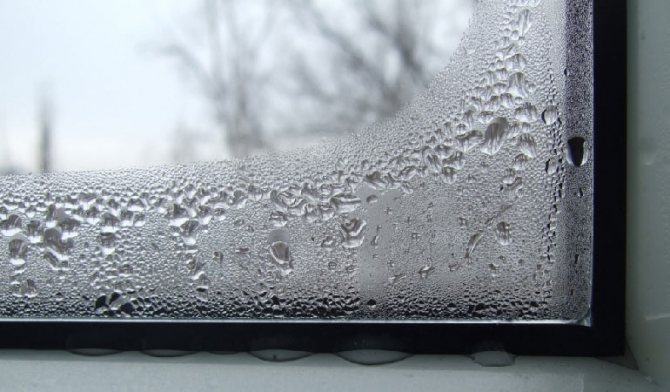

If a calculation error is made during the construction of a building, warm air leaving the room will collide with cold air and convert into condensation. As a result, droplets of moisture will appear on surfaces that are below the dew point.
The winter period in most regions of the country lasts a long time, is accompanied by consistently low temperatures, so the walls will be constantly wet.
This phenomenon can cause a lot of trouble for residents.
- The level of comfort in living quarters will decrease.
- High indoor air humidity will provoke chronic respiratory diseases.
- Damp wall structures are an ideal environment for mold growth.
Homes affected by wall fungus begin to collapse.
You can correct the situation on your own. To do this, you need to bring the dew point to the outside of the wall.
The best option is to insulate the house from the outside.This will help reduce the temperature difference and remove TR out. The thicker the insulating outer layer, the less likely it is that the dew point will fall on the wall structures.
Air humidity
In the correct definition of the concept of "dew point" there is another important physical term - isobaric air cooling. Few, looking at the puddles on the windowsill, formed from the moisture accumulated on the glass, will remember the Gay-Lossak law - the relative change in the volume of a given mass of gas at a constant pressure is proportional to the change in temperature.
Although people hear about air humidity every day in the weather forecast. The amount of water vapor in the ambient air, taken in a volume of 1 cu. m is called absolute humidity. But the relative humidity of the air is an indicator of the ratio of the amount of water vapor in the air (calculated as a percentage) to the maximum possible at the available temperature.
And it is when considering this characteristic that the concept of “dew point” arises. What it is? This is the temperature at which water vapor becomes saturated and is precipitated by water droplets at the present pressure. If the weather forecast indicates high relative humidity, the dew point temperature will approach the ambient temperature.
In everyday life, a person rarely thinks about such a concept as a dew point. Its definition is important only in some industries, in construction, medicine. But for everyone, a certain humidity of the surrounding air is important for good health. When the air is of sufficient humidity, it is easy and free to breathe, but if this indicator changes at constant pressure and ambient temperature, then either dryness or excess humidity is felt.
It is on the basis of the relative humidity of the air that the dew point can be determined. This phenomenon is a very complex and significant aspect of atmospheric physics. It is also important for human life. For example, builders know from experience that the dew point is a significant parameter of a high-quality building that affects the entire life of future residents or users.
Heating power reserve
In heating systems, small power reserves are needed, since the power of the system will increase with an increase in the number of batteries. For subscribers connected to a central heating system, this decision is not critical. But for individual heat consumers, large volumes bring additional costs for heating.
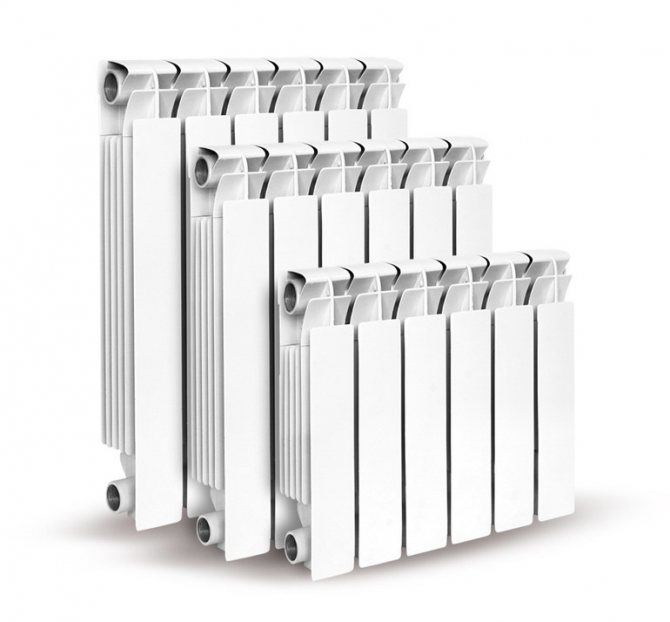

Having carried out the thermal calculation of the room, it will be possible to identify the need for sufficient heat consumption and determine the number of required heating devices. Any heating battery emits a given amount of heat specified in the technical documentation.
The calculator can calculate the heat load for heating a building for both private houses and industrial organizations.
It also helps in cases of lack of design data when calculating the exact coefficients of thermal conductivity of walls, as well as their composition. This methodology is successfully used in the consideration of cases in courts for litigation of housing and communal services.
Calculations are understandable even for ordinary subscribers who do not understand the intricacies of heat engineering issues. With the help of them, they double-check the correctness of the installation of heating boilers in private houses or apartments.
When calculating the indicators of thermal loads on heating elements in a building, should be considered:


- the purpose of the premises;
- characteristics of walls, doors, windows, roofs and ventilation systems;
- the size of the building;
- availability of premises for special purposes;
- availability of technical equipment;
- hot water supply;
- conditioners;
- additional balconies, loggias and bathrooms in the dwelling;
- the climate of the regions.
When calculating heat loss, take into account the street temperature.With insignificant temperature differences, less heat energy will be required to compensate for costs. If the outside temperature is very low, then more heat consumption will be required.
Formula for calculation
Tp = b γ (T, RH) a − γ (T, RH), {displaystyle T_ {p} = {frac {b gamma (T, RH)} {a-gamma (T, RH)}},} a {displaystyle a} = 17.27, b {displaystyle b} = 237.7 ° C, γ (T, RH) = a Tb T lnRH {displaystyle gamma (T, RH) = {frac {a T} { b T}} ln RH}, T {displaystyle T} - temperature in degrees Celsius, RH {displaystyle RH} - relative humidity in volume fractions (0 {amp} lt; RH {displaystyle RH} {amp} lt; 1.0 ). 0 ° C {amp} lt; T {displaystyle T} {amp} lt; 60 ° C 0.01 {amp} lt; RH {displaystyle RH} {amp} lt; 1.00 0 ° C {amp} lt; Tp {displaystyle T_ {p}} {amp} lt; 50 ° C Tp≈T − 1 − RH0.05. {Displaystyle T_ {p} approx T- {frac {1-R! H} {0.05}}.} RH≈1−0.05 (T − Tp ). {displaystyle R! Happrox 1-0.05 (T-T_ {p}).}
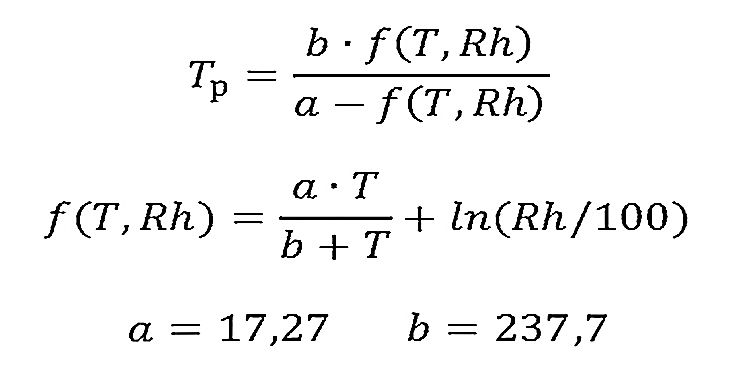

This formula can be used to calculate relative humidity from a known dew point
As you can see from the formula, the value directly depends on the values of two parameters:
- moisture index;
- actual temperature reading.
At high relative humidity, the parameter becomes higher and closer to the level of the actual temperature. To calculate this variable, there is a table with a small step of parameters. From it you can find the required value by measuring the relative humidity and the actual temperature.


Table 1. Determination of the indicator using the ratio of influencing parameters on which the dew point depends
The dew point itself, as a natural phenomenon, is calculated in several ways. The simplest one is represented by the formula in the figure below.
In it T
- dew point, RH - relative humidity, Т - temperature, digital values 243.12 and 17.62 are constant.
This formula gives an error of 1 0С, and if we take it into account, then the parameter will be calculated correctly enough.
How to calculate with minimum error?


To determine the dew point temperature, you do not need to rely on intuition and act "by eye". There are formulas that will allow you to accurately determine the temperature of condensation.
For calculations, the following mathematical formula is usually used:
TP = (B F (T, RH)): (A-F (T, RH)) Consequently F (T, RH) = A T: (B + T) + LN (RH: 100)
Here:
- TR - the required value;
- A – 17,27;
- B – 237,7;
- T - internal temperature;
- RH - value of relative humidity;
- LN Is the natural logarithm.
Calculate the dew point under the following conditions: internal temperature - 21 0C, air humidity - 60 %.
First, the function is calculated F (T,RH)... Substitute the desired values and get the following: 17.27 x 21: (237.7 + 21) + LN (60: 100) = 1.401894 + (-0.51083) = 0.891068.
Determine the dew point temperature: (237.7 x 0.891068): (17.27 x 0.891068) = 211.087: 16.37893 = 12.93167 ° C
In addition, you can use special tables (regulatory document SP 23-101-2004) or an online calculator offered by some construction sites.
Dew point and corrosion
The dew point of air is the most important parameter for anti-corrosion protection, it indicates humidity and the possibility of condensation.
If the dew point of the air is higher than the temperature of the substrate (the substrate is usually a metal surface), then moisture condensation will occur on the substrate.
Paint applied to a condensing substrate will not adhere properly unless specially formulated paints are used (see product data sheet or paint specification for help).
Thus, the consequence of applying paint to a condensation substrate will be poor adhesion and the formation of defects such as peeling, blistering, etc., leading to premature corrosion and / or fouling.
Why do you need to determine the dew point in construction?
Measuring dew point is a fairly simple task if you use certain formulas and rules. But why is it necessary for people involved in construction to know this natural parameter? Everything is very simple here - to understand the process of warming a room, because the layer that serves as an obstacle to cold and moisture can be located both on the inside of the room and on the outside, or it can be absent altogether.
- material and material thickness of all wall components;
- room temperature;
- outside temperature;
- indoor air humidity;
- air humidity outside the room.
The closer the dew point is physically to the inner surface of the wall, the longer the wall will be wet. This will happen when the air temperature drops both outdoors and indoors. Professional builders know that in order to create an optimal indoor climate in areas with a significant annual temperature variation, the building must first of all be insulated from the outside, having calculated the thickness of the insulating layer to correctly determine the physical location of the dew point in it.
Where is the dew point


Dew point location (TR) can be identified independently by visual inspection of the wall. Let's consider various situations with examples.
- Uninsulated walls... Here, the point can be in the middle of the structure, shifting to the inner surface during sharp cold snaps. In the first case, the inner surface will be dry if TR constantly shifted closer to the inner side, the surface will be damp throughout the cold season.
- With external insulation. If the work is done correctly, the dew point will fall on the insulation layer, and condensation will form here. This indicates correct construction calculations. If the layer of insulation is incorrectly calculated, TR can be located anywhere in the wall thickness.
- With internal insulation. Here the point will invariably be shifted towards the interior of the room. It can be located in the central part of the wall, directly under the insulation. The surface of the wall or the middle of the insulating layer will be partially damp. In this case, the material will be wet throughout the winter.
From the examples given, it can be seen that the dew point does not have an exact position and can shift with temperature changes.
Precise definition
Dew point values in ° C for a number of situations are determined using a sling psychrometer and special tables. First, the air temperature is determined, then the humidity, the substrate temperature and, using the Dew Points table, determine the temperature at which it is not recommended to apply coatings to the surface.
If you cannot find exactly your readings on the sling psychrometer, then find one indicator one division higher on both scales, both relative humidity and temperature, and the other indicator, respectively, one division lower and interpolate the required value between them.
ISO 8502-4 is used to determine relative humidity and dew point on steel surfaces prepared for painting.
Temperature table
Dew point values in degrees Celsius under different conditions are given in table [4].
| Relative humidity,% | Dry bulb temperature, ° C | ||||||||||
| 0 | 2,5 | 5 | 7,5 | 10 | 12,5 | 15 | 17,5 | 20 | 22,5 | 25 | |
| 20 | −20 | −18 | −16 | −14 | −12 | −9,8 | −7,7 | −5,6 | −3,6 | −1,5 | −0,5 |
| 25 | −18 | −15 | −13 | −11 | −9,1 | −6,9 | −4,8 | −2,7 | −0,6 | 1,5 | 3,6 |
| 30 | −15 | −13 | −11 | −8,9 | −6,7 | −4,5 | −2,4 | −0,2 | 1,9 | 4,1 | 6,2 |
| 35 | −14 | −11 | −9,1 | −6,9 | −4,7 | −2,5 | −0,3 | 1,9 | 4,1 | 6,3 | 8,5 |
| 40 | −12 | −9,7 | −7,4 | −5,2 | −2,9 | −0,7 | 1,5 | 3,8 | 6,0 | 8,2 | 10,5 |
| 45 | −10 | −8,2 | −5,9 | −3,6 | −1,3 | 0,9 | 3,2 | 5,5 | 7,7 | 10,0 | 12,3 |
| 50 | −9,1 | −6,8 | −4,5 | −2,2 | 0,1 | 2,4 | 4,7 | 7,0 | 9,3 | 11,6 | 13,9 |
| 55 | −7,8 | −5,6 | −3,3 | −0,9 | 1,4 | 3,7 | 6,1 | 8,4 | 10,7 | 13,0 | 15,3 |
| 60 | −6,8 | −4,4 | −2,1 | 0,3 | 2,6 | 5,0 | 7,3 | 9,7 | 12,0 | 14,4 | 16,7 |
| 65 | −5,8 | −3,4 | −1,0 | 1,4 | 3,7 | 6,1 | 8,5 | 10,9 | 13,2 | 15,6 | 18,0 |
| 70 | −4,8 | −2,4 | 0,0 | 2,4 | 4,8 | 7,2 | 9,6 | 12,0 | 14,4 | 16,8 | 19,1 |
| 75 | −3,9 | −1,5 | 1,0 | 3,4 | 5,8 | 8,2 | 10,6 | 13,0 | 15,4 | 17,8 | 20,3 |
| 80 | −3,0 | −0,6 | 1,9 | 4,3 | 6,7 | 9,2 | 11,6 | 14,0 | 16,4 | 18,9 | 21,3 |
| 85 | −2,2 | 0,2 | 2,7 | 5,1 | 7,6 | 10,1 | 12,5 | 15,0 | 17,4 | 19,9 | 22,3 |
| 90 | −1,4 | 1,0 | 3,5 | 6,0 | 8,4 | 10,9 | 13,4 | 15,8 | 18,3 | 20,8 | 23,2 |
| 95 | −0,7 | 1,8 | 4,3 | 6,8 | 9,2 | 11,7 | 14,2 | 16,7 | 19,2 | 21,7 | 24,1 |
| 100 | 0,0 | 2,5 | 5,0 | 7,5 | 10,0 | 12,5 | 15,0 | 17,5 | 20,0 | 22,5 | 25,0 |
Comfort range
A person with high values of the dew point feels uncomfortable. In continental climates, conditions with a dew point between 15 and 20 ° C cause some discomfort, while air with a dew point above 21 ° C is perceived as stuffy. A lower dew point, less than 10 ° C, correlates with lower ambient temperatures and the body requires less cooling [unspecified 2825 days].
| Dew point, ° C | Human perception | Relative humidity (at 32 ° C),% |
| more than 26 | extremely high perception, deadly for asthma patients | 65 and up |
| 24—26 | extremely uncomfortable state | 62 |
| 21—23 | very humid and uncomfortable | 52—60 |
| 18—20 | unpleasantly perceived by most people | 44—52 |
| 16—17 | comfortable for most, but the upper limit of humidity is felt | 37—46 |
| 13—15 | comfortable | 38—41 |
| 10—12 | very comfortable | 31—37 |
| less than 10 | a little dry for some | 30 |
The dew point calculation is a rather complex algorithm that requires not only knowledge of certain physical parameters, but also the ability to use certain mathematical formulas.A complex and rather lengthy calculation process can be removed by using tabular values. In such tables, the relative humidity and ambient temperature are indicated. The intersection of these parameters in the table grid gives the dew point temperature.
Water vapor most often condenses on the walls themselves or within their structure if they are not sufficiently insulated or built. Without insulation, the value will be close to the temperature of the inside of the wall, and in some cases to the wall in the middle of the house. When the temperature inside the enclosing structures is below the indicator, then during a cold snap at a negative temperature outside, condensation will fall out.
There are several places where the indicator can be located on non-insulated structures:
- inside the structure, close to its outer part, the wall will remain dry;
- inside the wall, but close to the inside, the wall becomes wet with temperature changes;
- the side of the wall that is in the building will constantly be covered with condensation.
Experts do not recommend insulating the premises from the inside, explaining this by the fact that when using this method of thermal insulation, the parameter will be under the insulating layer in the middle of the room. As a result, a large accumulation of moisture will occur.
- condensation can accumulate in the center of the wall and, during cold weather, move towards the location of heat-insulating components;
- the place of accumulation of moisture can be the border of the enclosing structure and the insulating layer, which damp and forms mold in the middle of the rooms;
- in the middle of the insulating layer itself (it will gradually be saturated with moisture, will begin to mold and rot from the inside).


The dew point is formed by three components: atmospheric pressure, air temperature and humidity.
Styrofoam, mineral wool or another type of insulation must be placed on the outside of the building, which will allow the value to be placed in the insulating layer (with this arrangement, the walls inside will remain dry). For a clearer understanding of the parameter, there are graphs of its placement on the walls of houses with insulation, as well as on buildings that do not have an insulation layer. To make such a calculation yourself, you can determine the dew point in the wall with a calculator.
The result of errors made during the calculation of the parameters will be a constant accumulation of condensation, high humidity, the development of fungal deposits and mold. Industrial, administrative or residential premises will not be able to serve for a long time: negative processes will accelerate destruction. Additional costs will be required for ongoing maintenance and overhaul.
Calculator for calculating heating radiators by area
The area register calculator is the easiest way to determine the required number of radiators per 1m2. Calculations are made on the basis of the norms of the produced capacity. There are 2 main provisions of the norms, taking into account the climatic features of the region.


Basic norms:
- For temperate climates, the required power is 60-100 W;
- For the northern regions, the norm is 150-200 watts.
Many people wonder why there is such a large range in the norms. But the power is selected based on the initial parameters of the house. Concrete structures require maximum power ratings. Brick - medium, insulated - low.
All norms are taken into account with an average maximum shelf height of 2.7 m.
To calculate the sections, you will need to multiply the area by the norm and divide by the heat transfer of one section. Depending on the radiator model, the capacity of one section is taken into account. This information can be found in the technical data. Everything is quite simple and does not present any special difficulties.
Condensation on the windows
New technologies make life more comfortable.For example, plastic windows made it possible to make buildings more protected from the vagaries of the weather, external sounds, to keep warm more efficiently, to abandon the routine autumn-spring duty of caulking and excavating window frames. But this option works 100% only if the windows are installed in compliance with all parameters, including taking into account such a factor as the dew point temperature.
Wooden window frames, even if they are well caulked, have natural micropores that serve as a kind of ventilation ducts. These frames are said to be "breathing". But plastic windows are deprived of a much-needed component for creating a comfortable microclimate. That is why, when humidity and temperature cease to be in a certain equilibrium, windows begin to “cry” - moisture accumulates on glass and plastic bulkheads, flowing down and forming puddles on the windowsills.
This negatively affects the condition of the premises - the humidity rises, the objects in it can become damp, moldy. When installing plastic windows, you should always remember that the dew point depends on two factors - the temperature of the window surface and the humidity in the room.
A single-chamber window in a climate with low air temperatures will in any case “cry” if such a window is in a heated living room. Therefore, in this case, it is recommended to install not even two, but three-chamber windows. Then the inner glass will be hot enough compared to the outer glass to stay dry.
Very often, modern window manufacturers have to accept claims that their customers are fogging up their windows. The formation of condensation on windows is not only aesthetically unattractive, but also threatens with waterlogging of wooden structures and, as a result, the formation of moldy mildew. Let's take a look at the possible causes of condensation on the windows.
Well, if this happened on the windows, then only the windows and their manufacturers are to blame. Logically, this is correct, but if there is no water in the window itself and it cannot emit it, where does the condensate come from?
Single-chamber double-glazed window - do not save on double-glazed windows, as they say, a stingy person pays twice. An ordinary double-glazed unit with one chamber (not energy-saving) will surely allow you to get acquainted with condensation on the windows. To eliminate the cause of fogging, it is necessary to replace the glass unit, not the entire window, but only the glass unit.
Wrong
Correctly
Heating radiators blow warm air over the window, and if they are blocked by a window sill, then there will be no warm air circulation - the window will always be cold, as a result, condensation will appear on it.
You can get rid of the appearance of condensation by reducing the size of the window sill or by removing the battery outside the window sill. If there is no possibility for such options, you will have to look for an additional source for glass heating.
Poor ventilation
Ventilation grilles tend to be often clogged with all sorts of rubbish - dust, cobwebs, after which they stop drawing in moist air, moisture settles on the glass and the windows begin to cry. And in old houses, the ventilation ducts are almost always clogged and have never been cleaned.
An example of the organization of air flow: ventilation and air ionization
You can eliminate the formation of condensation by cleaning or replacing the grilles, and if the ventilation is clogged and there is no way to clean it, you will have to do additional ventilation.
Dew point observations
The highest dew point temperature was 35 ° C and was recorded in Jask (Iran) on July 20, 2012.
The dew point calculation is an important parameter for carrying out many types of technical work, for human health. It is included in physical natural phenomena and can relate to such a science as meteorology - observing the weather.This field of nature study originated a very long time ago, but as a scientific field it was organized in the 17th century, when Galileo Galilei invented a thermometer, and Otto von Guericke - a barometer.
Measurements of temperature, air humidity, atmospheric pressure made it possible to draw a conclusion about such a parameter as the dew point. It is not known exactly when it was first recorded and began to be used in various spheres of human life, but observations and fixation of this physical phenomenon are carried out constantly in all points of the globe.
The highest dew point temperature was recorded in the Iranian town of Jaska on July 20, 2012 and was 35 ° C. Now you can understand why, with an increase in air humidity and ambient temperature, it becomes difficult to breathe - in this, such a parameter as the dew point plays a role. What it is? Factor of the ratio of air humidity and temperature at which moisture condenses.
Dew point device
To determine TR you can use special devices for measuring air humidity. A condensation hygrometer will help you find the value you are looking for. The device is easy to use, and the principle of operation is based on a built-in mirror surface that reacts to the ambient temperature.
The primary measurement determines the temperature of the mirror. Condensation forms on the surface and the measurement is repeated. The difference in values will show the absolute or relative humidity of the air. Precise instrument settings help you determine the dew point for any surface.
Dew point and metal breakdown
Technical developments made it possible not to calculate the dew point by formulas, but to use a special device that automatically determines this parameter for moisture and hydrocarbons - this is the so-called dew point analyzer. It is used by professionals during certain types of work, for example when applying a protective coating to devices and systems made of materials that are corroded due to high humidity.
After all, if the surface before applying the coating has insufficient dryness, then the applied protection will not work, since sufficient adhesion, that is, adhesion between the materials, will not appear. The painted surface will become covered with bulges, cracks, and the base material will continue to deteriorate even under protection. It is for high-quality corrosion protection that it is necessary to know the dew point, calculating it using formulas and analyzers.
Notes (edit)
- ↑ RMG 75-2004 "GSI. Measurements of the moisture content of substances. Terms and definitions "(RMG 75-2014 begins to operate from 01.08.2015)
- ↑ JV 50.13330.2012 "Thermal protection of buildings"
- ^ John M. Wallace, Peter V. Hobbs. Water Vapor in Air // Atmospheric Sience. An introductory Survey .. - Second edition. - Washington: Academic Press Elsevier, 2006 .-- S. 83 .-- 551 p. - ISBN 978-0-12-732951-2.
- ↑ ISO 8502-4, Preparation of steel surfaces prior to application of paints and related products. Tests to assess surface cleanliness. Part 4. Guidance on the assessment of the likelihood of condensation prior to paint application "
Home insulation - outside or inside?
The formula for calculating the dew point in everyday life is of little use to anyone. But in some industries and spheres of human activity, it is impossible to do without it. The dew point, the definition of which was discussed above, is an important parameter for high-quality construction and arrangement of premises for any purpose.


Whatever the building, it must be dry, which means that the dew point in the wall must be either completely eliminated or reduced to the maximum distance from the inner surface. For example, the construction and insulation of buildings will necessarily require such calculations. Today you can find many table pointers with already calculated values.
But many use formulas to confirm the specified data and to determine the dew point as accurately as possible for high-quality thermal and waterproofing of premises under specific conditions. In this case, it is necessary to take into account the parameters of the materials of the walls, insulation, vapor barrier. Experienced builders say that the dew point is not a stationary indicator, it constantly moves with a change in external factors.
Internal insulation remains relatively popular despite the physics.
It would seem, why not insulate the apartment inside the building? Especially if you live on the 10th floor? The idea is tempting, but absolutely absurd.
Of course, working at home with your own hands without any mountaineering or stairs is much more pleasant and convenient, but there are a number of significant obstacles:
- A layer of insulation will cut off the walls from the heating system, and in winter they will freeze through. This will lead to their rapid wear.
- The position of the dew point will be inside the wall at best, but most likely it will be located directly under the layer of insulation.
- The volume of the living space will significantly decrease due to the thickness of the thermal insulation layer.
- The walls will stop absorbing moisture, the humidity in the room will rise, which will feel uncomfortable. In some cases, a strong increase in humidity leads to asthma.
- The soaked walls are a great habitat for mold and bacteria.
If my warnings did not convince you, then read the provisions dictated by the SNiP and GOST instructions.
The photo shows options for moisture protection, but they do not solve all of the listed problems.
Internal insulation can be justified only in cases where the external location of thermal insulation is for some reason impossible. The slightest mistake in calculations or performance of work can lead to disastrous consequences.
Water is a serious enemy of building structures.
Measurement tools
The concept of dew point is widely used at gas metering stations, at automobile gas filling compressor stations, at stations for underground storage and drying of natural gas, for checking hygrometers and wet gas generators. The dew point is an important characteristic for high-quality operation both for residential and industrial premises, as well as for gas pipelines and gas storage systems.
A dew point measuring device allows you to abandon complex calculations using formulas and calculate this parameter while independently measuring environmental factors - temperature, humidity and pressure. The very first developed device is a psychrometric hygrometer, it is also called a psychrometer. Now this is a laboratory device that is not used in practice.
The development of electronic computational analyzers did not miss such a physical parameter as the ratio of humidity and temperature of the ambient air, and hence the calculation of the dew point. Such devices are easy to operate, although some models, including those with the properties of a thermal imager, require processing of the information received using special computer programs.
